Liszt refused to place Beethoven's works in periods. He would divide them, instead, into two categories.
The first, that in which traditional and recognized form contains and governs the thought of the master; and the second, that in which the thought stretches, breaks, and recreates, and fashions the form and style according to its own needs and inspirations. . . . Beethoven is like the ancient Janus; one of his two faces is turned to the past, the other towards the future.1
These faces are in evidence wherever one looks, whether it be a search involving details or broad design. As Liszt's analogy relates to Neapolitan formations, the principal focal point of this study, Beethoven continues the use of the Neapolitan chord as he inherited it, i.e., N6 - V7 - i. On the other hand he gives the chord root position status and ultimately treats it as a fundamental chord with relationships of its own in major as well as in minor keys, the relationships being keys implied by its fundamental tones. Collectively these keys constitute a tonal region made of  - iv -
- iv -  . This brief presentation shows some of the evolutionary steps as Beethoven moves ever forward and expands his use of Neapolitan formations to become building stones in his mammoth structures.
. This brief presentation shows some of the evolutionary steps as Beethoven moves ever forward and expands his use of Neapolitan formations to become building stones in his mammoth structures.
Space limitations permit presenting illustrative material from only four sonatas: Opus 10, No. 3 in D Major; Opus 27, No. 2 in C-sharp Minor; Opus 57 in F Minor, and Opus 106 in B-flat Major. The first use of the  - iv -
- iv -  region as the harmonic basis of a principal section in Beethoven's piano sonatas is in the development section of the first movement of Opus 10, No. 3, the date of publication for this work being 1798. While the region appears in some of the earlier sonatas, the bold use of it to build a principal section in this sonata signifies a confidence that is not evident in earlier usage. In the light of what is to come, it could even signify a moment of decision.
region as the harmonic basis of a principal section in Beethoven's piano sonatas is in the development section of the first movement of Opus 10, No. 3, the date of publication for this work being 1798. While the region appears in some of the earlier sonatas, the bold use of it to build a principal section in this sonata signifies a confidence that is not evident in earlier usage. In the light of what is to come, it could even signify a moment of decision.
The last movement of Opus 27, No. 2 furnishes examples showing Neapolitan formations juxtaposed first with the minor dominant in the exposition, the minor subdominant in the development section, and finally with the tonic in the recapitulation. Recurring juxtaposition of Neapolitan formations with the traditional tonal pillars to delineate the structure of this movement is without precedent.
In Opus 57, juxtapositions involving Neapolitan formations appear in the outer movements and serve as a principal unifying device not for a single movement as in Opus 27, No. 2 but for the entire work. Moreover, the fundamental tones of the Neapolitan chord generate relationships in much the same way the fundamental tones of the dominant and subdominant generate relationships in Mozart's works. It is this capability, juxtapositions involving Neapolitan formations notwithstanding, that elevates the use of the  - iv -
- iv -  region in Opus 57 to a position far in advance of previous uses of the region in Opus 10, No. 3 and Opus 27, No. 2.
region in Opus 57 to a position far in advance of previous uses of the region in Opus 10, No. 3 and Opus 27, No. 2.
Illustrative material from the sonatas enumerated thus far suffices to present an evolutionary view of Beethoven's use of Neapolitan formations, albeit somewhat truncated. Two examples from Opus 106 serve to present only a glimpse of what happens towards the end of Beethoven's compositional experience. Space limitations preclude showing how hexachordal formations relating to the tonic and Neapolitan regions permeate the structure of the entire sonata.
OPUS 10, NO. 3 IN D MAJOR
The Opus 10, No. 3 Sonata shows that the use of the  - iv -
- iv -  region expands Beethoven's tonal spectrum to include the related keys of both major and minor keys built on the same tonic. All four have D as the home tonic. Sir Donald Tovey speaks to this point in his inimitable style as follows:
region expands Beethoven's tonal spectrum to include the related keys of both major and minor keys built on the same tonic. All four have D as the home tonic. Sir Donald Tovey speaks to this point in his inimitable style as follows:
The first basis of wider key-relation is that major and minor keys on the same tonic are identical. The fact that the so-called 'relative major' is a convenient point of backward reference has nothing to do with the matter; it is an accident that has misled the tonic-sol-faists, but has misled nobody else. Not A Minor, but C Minor is the minor mode of C.2
In the example illustrating this point (Ex. 1), C is the home tonic. The descending scale, C Minor with a flatted second degree, mirrors the ascending scale, C Major. Roman numerals designate keys as they relate to the home tonic. They may, of course, also designate triads.
Ex. 1. Keys in Beethoven's tonal spectrum.

No cadence marks the end of the exposition in the first movement of the D Major sonata. Instead, repetitions of the principal motive gradually drop the sharps of the dominant key and deflect to the minor mode of the home tonic. A rise to the dominant recalls the opening bars of the sonata, there being a fermata over the dominant here as in the beginning. A fortissimo eruption on B-flat ( ), a surprise to say the least, leads to a sequence based on the Neapolitan region, the first of three eight-bar segments being on B-flat. The last segment on E-flat breaks the sequence and turns to a dominant preparation for the return of D Major in the recapitulation. In the broadest sense, the progression of the entire development section following the deflection to the minor mode is: i -
), a surprise to say the least, leads to a sequence based on the Neapolitan region, the first of three eight-bar segments being on B-flat. The last segment on E-flat breaks the sequence and turns to a dominant preparation for the return of D Major in the recapitulation. In the broadest sense, the progression of the entire development section following the deflection to the minor mode is: i -  - iv-
- iv-  - V7 - I. Example 2 shows the last segment of the sequence on
- V7 - I. Example 2 shows the last segment of the sequence on  (E-flat Major).
(E-flat Major).
Ex. 2. Beethoven, Sonata in D Major, Opus 10, No. 3, first movement (Presto), measures 153-64.
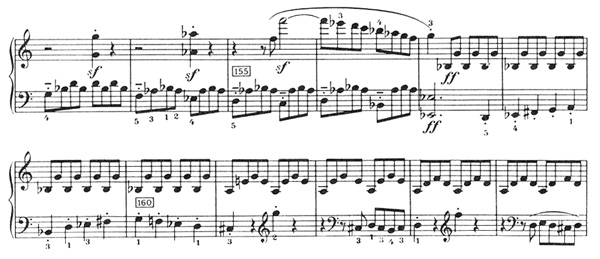
Beethoven follows tradition in this sonata movement and turns to the dominant for the second group in the exposition. What happens after the turn is perhaps without precedent; Beethoven is simply unable to resist development. A deflection to the dominant minor leads to a series of four-bar passages each of which consists of four tonicizations of regions in the dominant minor, namely,  , iv, and
, iv, and  (C Major, D Minor, and B-flat Major). This passage returns in the recapitulation in the tonic minor. Thus on either side of the Neapolitan region in the development there is a similar use of the region in which
(C Major, D Minor, and B-flat Major). This passage returns in the recapitulation in the tonic minor. Thus on either side of the Neapolitan region in the development there is a similar use of the region in which  substitutes for
substitutes for  . Example 3 shows the return of the major mode following
. Example 3 shows the return of the major mode following  (B-flat Major).
(B-flat Major).
Ex. 3. Beethoven, Sonata in D Major, Opus 10, No. 3, first movement (Presto), measures 81-93.
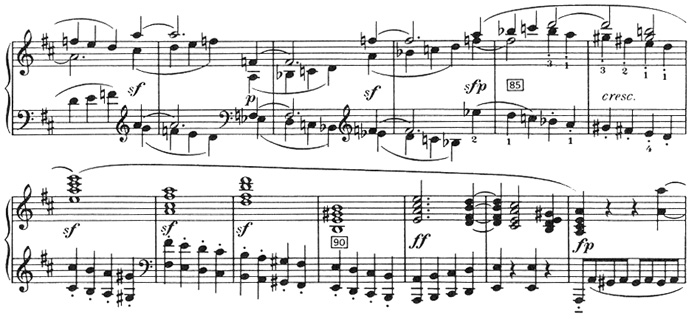
The progression outlining the Neapolitan region in the development of the first movement returns in the final movement, again as a sequence and, again, following a sudden eruption on B-flat ( ) (Ex. 4).
) (Ex. 4).
Ex. 4. Beethoven, Sonata in D Major, Opus 10, No. 3, fourth movement Allegro (Rondo), measures 31-40.
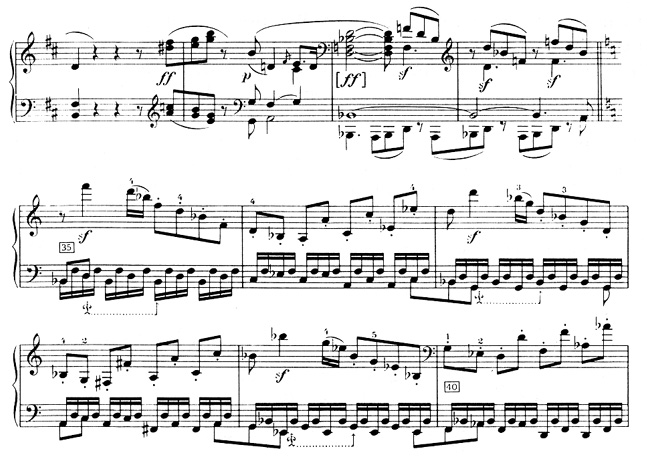
It constitutes the second episode of the rondo. Thus, the progression occurs at approximately the midpoint of each of the outer movements and serves as a unifying factor for the entire work. It also plays an important role in counterbalancing the outer movements of the sonata. The motive at the beginning of the rondo is an inversion of the opening motive of the first movement. As a result, the descending arpeggiations in the upper register in the setting of the progression in the rondo counterbalance the ascents in the lower register in the development section of the first movement.
I cite unifying factors recurring in separate movements with some trepidation because Tovey, even in the face of cogent evidence, did not believe that such things happen in Beethoven's sonatas. Roger Sessions, on the other hand, alerts the analyst to the existence of such relationships as follows:
Sometimes . . . one of the most important musical ideas, in a fundamental and motivating sense, may be not even in a thematic fragment at all but some feature of the large design, such as a recurring relationship between two harmonies or keys, or even in a linear relationship embodied in different aspects of the music at different times.3
The evidence presented thus far projects a number of recurring relationships. As this evolutionary view of Beethoven's Neapolitan formations continues unfolding, the cumulative evidence provides some insight into how it is that as Beethoven matures, his multimovement structures become increasingly coherent entities.
OPUS 27, NO. 2 IN C-SHARP MINOR
The "Neapolitan Sonata" would be more appropriate than "The Moonlight" as a title for Opus 27, No. 2, except for one thing. That is, as vital as Neapolitan formations are in molding the form of the final movement of Opus 27, No. 2, this sonata is a progenitor for an infinitely more profound use of the juxtaposition of a tonic with its Neapolitan in Opus 57. Thus the title is more appropriate for the later sonata. Since I find the "Appassionata" singularly appropriate for Opus 57, I will not try to start a fad by referring to either sonata as the "Neapolitan." But I do not have to call Opus 27, No. 2 the "Moonlight."
Traditional usage of the Neapolitan sixth appears in the first movement of Opus 27, No. 2 in the N6 - V7 - i progression beginning in measure 3 of Example 5.
Ex. 5. Beethoven, Sonata in C-sharp Minor, Opus 27, No. 2, first movement (Adagio sostenuto), measures 1-5.
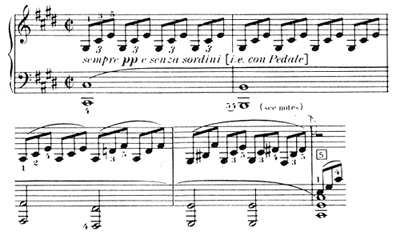
Compare this tranquil beginning with the powerful sweep of the passage in which essentially the same progression appears in a somewhat more elaborate setting in the approach to the final cadence of the final movement (Ex. 6).
Ex. 6. Beethoven, Sonata in C-sharp Minor, Opus 27, No. 2, third movement (Presto agitato), measures 176-83.
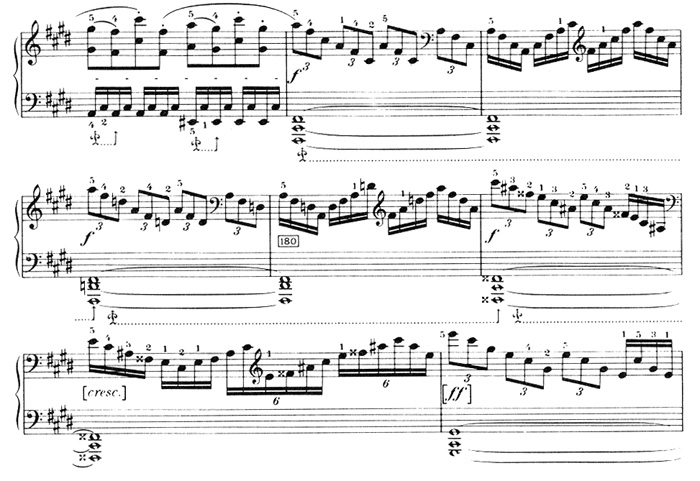
While the progression itself remains traditional, the treatment is in keeping with the imaginative uses of Neapolitan formations in each of the principal sections of the closing movement. With each chord filling two bars, the progression is, beginning in measure 177: iv - N6 vii°7 / V - i - V7leading into a close of eleven bars of tonic-dominant exchange over a tonic pedal.
- V7leading into a close of eleven bars of tonic-dominant exchange over a tonic pedal.
Beethoven breaks with tradition in his use of Neapolitan formations in the main body of the final movement where they become a powerful factor in delineating the sections of the sonata movement. The first of these formations furnishes most of the material for the second group in the exposition. Its juxtaposition with the minor dominant (G-sharp Minor) (Ex. 7) comes as somewhat of a surprise.
Ex. 7. Beethoven, Sonata in C-sharp Minor, Opus 27, No. 2, third movement (Presto agitato), measures 26-44.
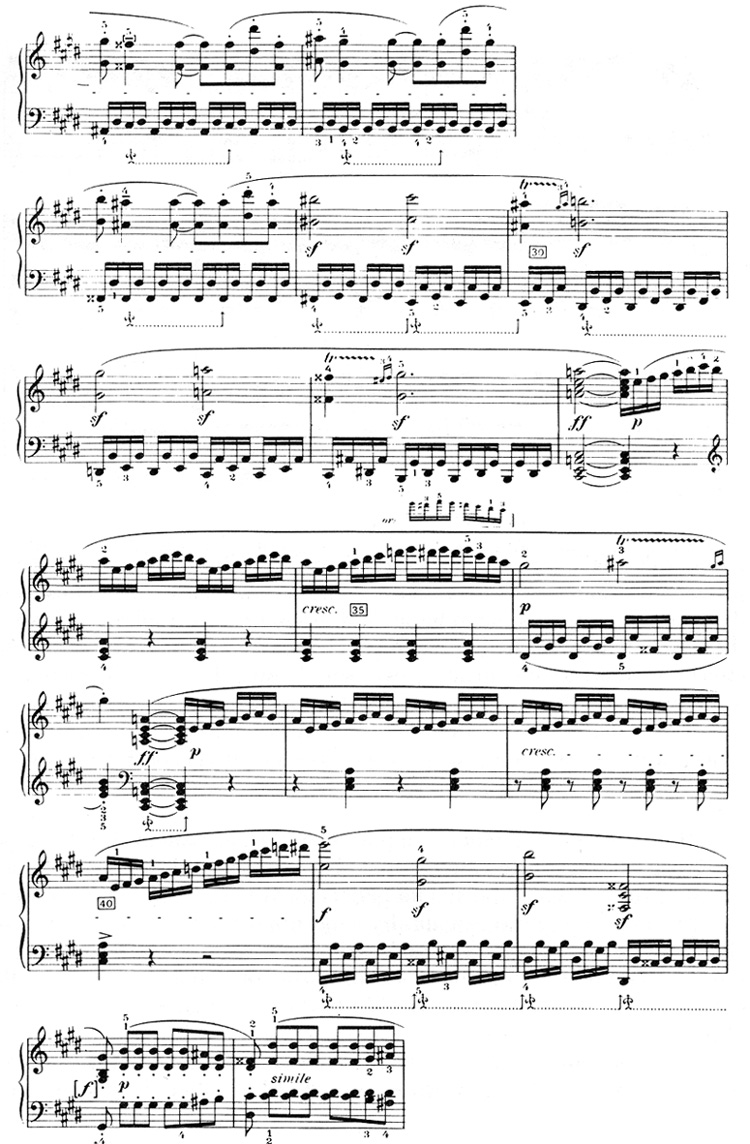
As the eruption on  in the Opus 10, No. 3 Sonata illustrates, Beethoven is not bashful when he does something new and different. The fortissimo crash on the Neapolitan sixth in measure 33 furnishes another bold example. The three-measure flourish on the chord that follows this crash only to be repeated after a deceptive close is, insofar as I know, without precedent. A listener, even an unwary one, grasps the form-delineating significance of this passage when it returns in the tonic in the recapitulation. Example 7 runs to considerable length to show how the elaborations on the Neapolitan dominate the second group. Note that the extended flourish culminates in a traditional cadence involving the Neapolitan sixth (measures 41-43).
in the Opus 10, No. 3 Sonata illustrates, Beethoven is not bashful when he does something new and different. The fortissimo crash on the Neapolitan sixth in measure 33 furnishes another bold example. The three-measure flourish on the chord that follows this crash only to be repeated after a deceptive close is, insofar as I know, without precedent. A listener, even an unwary one, grasps the form-delineating significance of this passage when it returns in the tonic in the recapitulation. Example 7 runs to considerable length to show how the elaborations on the Neapolitan dominate the second group. Note that the extended flourish culminates in a traditional cadence involving the Neapolitan sixth (measures 41-43).
Yet another juxtaposition involving a Neapolitan formation appears in the central portion of the development section. This section begins with the opening theme in tonic major treated as the dominant of F-sharp Minor. The minor subdominant key moves to D Major (its  ) as the dominant of its Neapolitan and returns to F-sharp Minor following a brief excursion in G Major (its
) as the dominant of its Neapolitan and returns to F-sharp Minor following a brief excursion in G Major (its  ) (Ex. 8).
) (Ex. 8).
Ex. 8. Beethoven, Sonata in C-sharp Minor, Opus 27, No. 2, third movement (Presto agitato), measures 75-83.
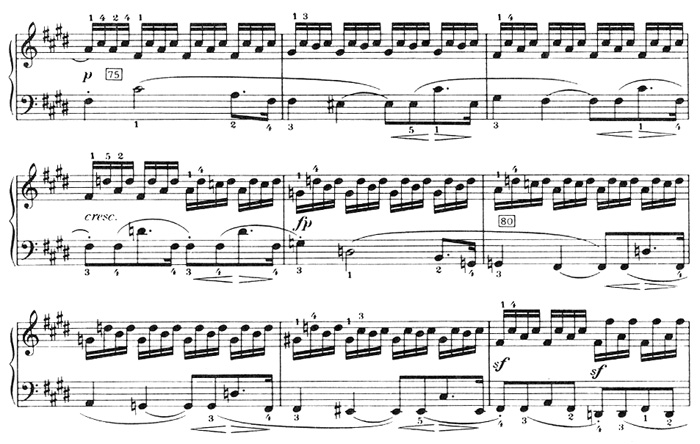
The use of the principal theme of the second group establishes an unequivocal kinship with the other principal sections of this movement. The overall treatment of the form in this movement furnishes a solid basis for a proposal that Opus 27, No. 2 is the impetus for the creation of Opus 57.
OPUS 57 IN F MINOR
Rudolph Réti shows how all of the themes in Beethoven's Opus 57 grow out of the motivic intervals in its opening bars, the chief interval among them being the minor second.4 While I am more or less in agreement with Réti's proposals regarding the contribution of the thematic process to organic growth, I am nonetheless puzzled by his almost total disregard for a time-scale in his analytical discussions. I might add parenthetically that disregarding a temporal sequence or musical cause-and-effect is no less puzzling in analyses of serial music. I am convinced that no one can see that Beethoven is a radical composer for his time without an understanding of how he operates in a harmonic time-span. This conviction compels me to add to Réti's proposals my own proposal that the opening bars of Opus 57 also generate the tonal framework of the entire sonata (Ex. 9).
Ex. 9. Beethoven, Sonata in F Minor, Opus 57, first movement (Allegro assai), measures 1-13.
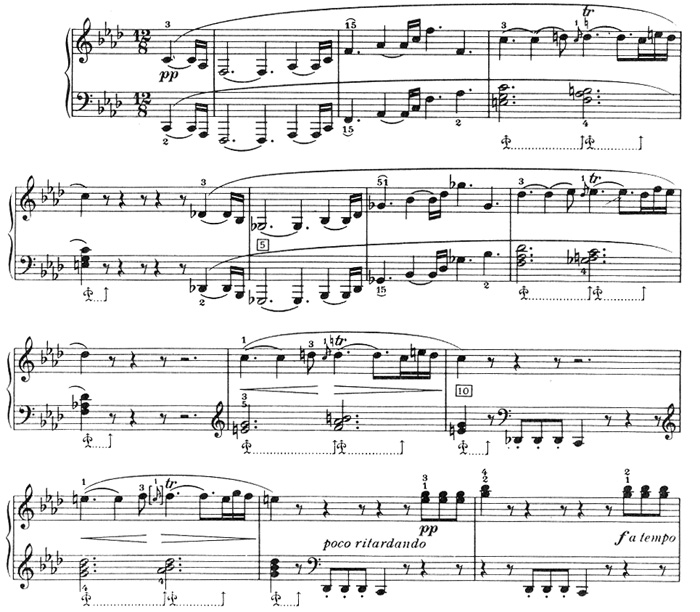
If one accepts the generative powers of the Neapolitan chord as a patent harmonic fact, one can see that the tonic-Neapolitan juxtaposition stated at the outset of the sonata generates keys that make up the tonal framework of the entire sonata. By superimposing the tones of the two chords in thirds, designating the key that each tone generates, and showing the relation of each to the home tonic, the following keys result: G-flat,  ; B-flat Minor, iv; D-flat,
; B-flat Minor, iv; D-flat,  ; F Minor (home tonic); A-flat,
; F Minor (home tonic); A-flat,  ; and C Minor, v.
; and C Minor, v.
If one should question that the fundamental tones of these juxtaposed chords imply keys, Beethoven leaves little doubt of his intentions in the development section of the first movement (Ex. 10) where he lines out the implied keys as tonicized regions in symmetrically-arranged sequences on either side of the tonic, the tonic itself being absent.
Ex. 10a. Beethoven, Sonata in F Minor, Opus 57, first movement (Allegro assai), beginning of the development in E on opening theme (measures 65-78); the first segment of the sequence in e (measures 79-82).
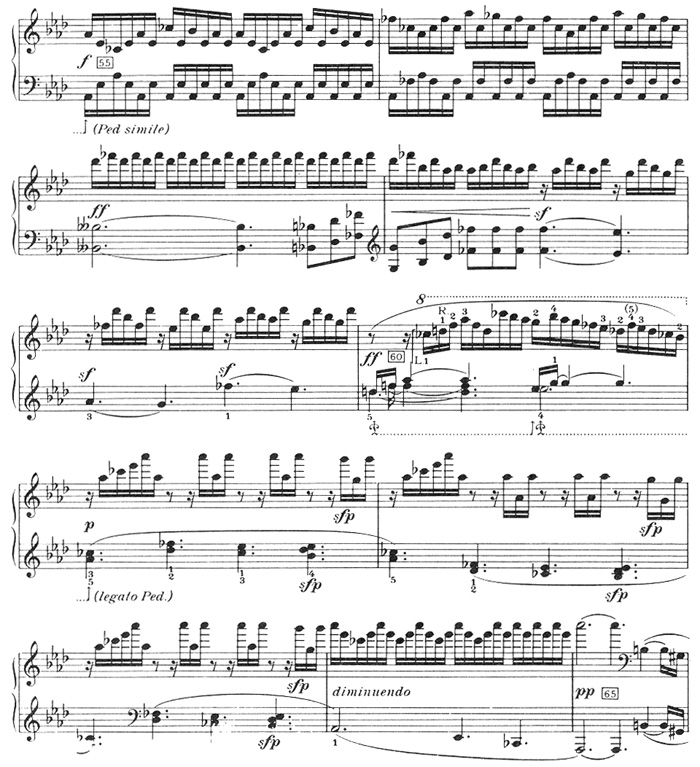
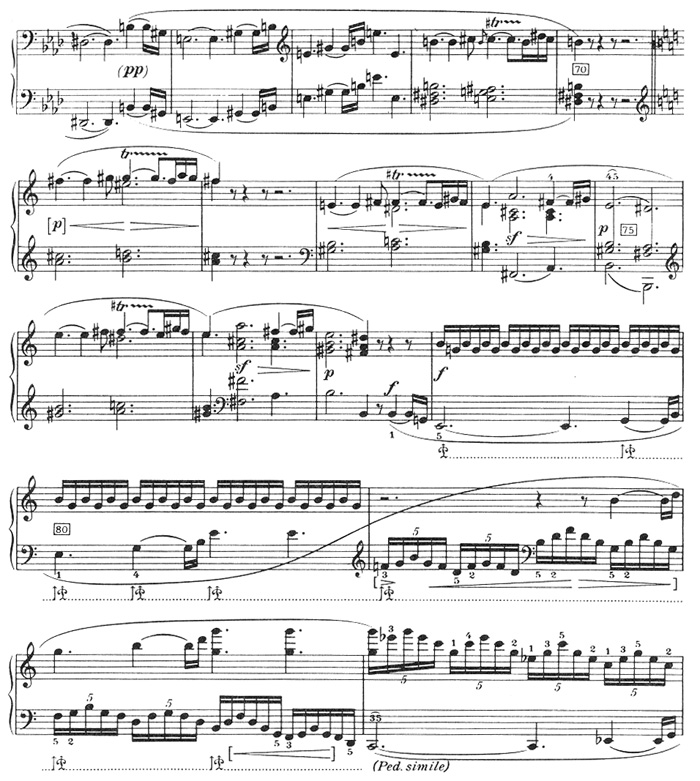
Theoretically, nonetheless, the tonic lies at the center of the two sequences, the first ending a third above it on A-flat, the second beginning a third below on D-flat. Working both forward and backward from the center perhaps explains the symmetry of the passage in the clearest way.
Ex. 10b. Part of the dominant preparation for D-flat Major, the key in which the first segment of the second sequence begins (measures 94-97).

Turning backward from A-flat, the sequence extends in segments by thirds from C Minor to E Minor, an indirect Neapolitan relation to the tonic. Proceeding forward from D-flat, the second sequence continues in segments by sixths from B-flat Minor to G-flat Major, thus completing the outline of the Neapolitan region.
Ex. 10c. The move from B-flat Minor to G-flat Major, the end of the second sequence (measures 116-18).

A crucial point for the understanding of the symmetrical design of the development section is that chains of thirds (or sixths) fan out from the center and extend in each direction to within a minor second of the home tonic. An outline of the form of this movement accompanies the text as an aid for locating structural details.
Now Beethoven's intentions are clear. These tonicized regions project the keys that are to serve as the tonal framework of the entire sonata. The exposition of the first movement moves from F Minor to A-flat Major and then deflects to A-flat Minor. The middle movement turns to D-flat and there it remains. The exposition of the final movement proceeds from F Minor to C Minor. The principal key region of the development section in the final movement is B-flat Minor. The final coda touches upon A-flat Major once again before the final juxtapositions of the home tonic with its Neapolitan which conclude the sonata. Note the absence of G-flat (the Neapolitan key) as a key for a principal section. For all its independence as a fundamental chord capable of generating relationships at this stage of Beethoven's career, he is not ready to use the Neapolitan key as the tonal basis for a principal section outside of a development.
Juxtapositions involving Neapolitan formations occur in Opus 27, No. 2 only in the final movement in which they operate in conjunction with the principal theme of the second group. In Opus 57, juxtapositions occur in the outer movements. In both movements they appear in conjunction with the principal theme of the first group. Thus, the tonic (F Minor) appears in numerous juxtapositions with its Neapolitan (G-flat Major). In addition to its unifying powers, this recurring relationship marks the beginnings of the exposition and recapitulation in both movements and thus aids in delineating the form. In addition, this relationship also appears in B-flat Minor in the development section of the final movement. Yet another example recurs in this section. This is F Minor - G-flat Major, not as i -  , but as v -
, but as v -  in B-flat Minor. The last tonic-Neapolitan relationship comes in the coda of the final movement in the traditional cadential formula—i - N6 - V7 - i—twice repeated, the precedent for this kind of dramatic elaboration leading to a final close having been set in Opus 27, No. 2 (Ex. 6).
in B-flat Minor. The last tonic-Neapolitan relationship comes in the coda of the final movement in the traditional cadential formula—i - N6 - V7 - i—twice repeated, the precedent for this kind of dramatic elaboration leading to a final close having been set in Opus 27, No. 2 (Ex. 6).
It is singularly appropriate for Beethoven to summarize the tonal poise of this sonata with this progression, and particularly for this final movement because the progression plays such an important role in the entire movement. Whereas Beethoven withholds cadences altogether in the first movement until measure 238 at the beginning of the final section marked più allegro, cadences abound in the final movement. They are elisions, to be sure, so as not to disrupt the cumulative drive, but they are cadences nonetheless. The beginning of the exposition illustrates this point (Ex. 11).
Ex. 11. Beethoven, Sonata in F Minor, Opus 57, third movement (Allegro ma non troppo), measures 20-28.
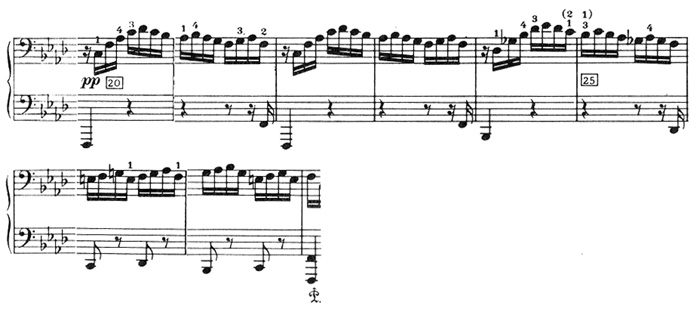
A similar situation prevails in the second group of the exposition. It begins in measure 76 with three repetitions of N6 - vii°6 - i in C Minor, the third time continuing downward by step to a cadence. Instead of moving to the tonic it progresses to an N6 (measure 86) which, in turn, begins a repetition of the previous ten measures with more complete harmonies in the next octave below. Example 12 begins with the repetition and culminates the second time in a cadence (measure 96).
Ex. 12. Beethoven, Sonata in F Minor, Opus 57, third movement (Allegro ma non troppo), measures 86-97.
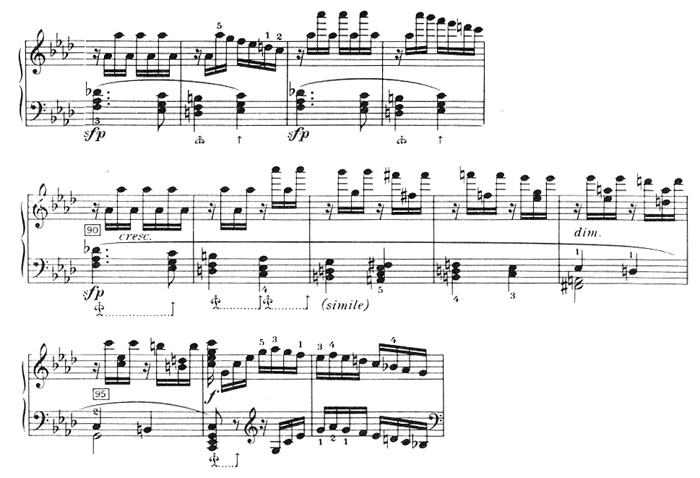
OPUS 106 IN B-FLAT MAJOR
While space limitations preclude pursuing the evolutionary stages leading up to the "Hammerklavier," a couple of examples from this sonata will suffice to show how far Beethoven extends in his use of Neapolitan formations. Example 13 shows that at this stage, Beethoven "sheds the tops" of the Neapolitan chord, as it were, and approaches the final cadence of the Scherzo with a long play on B-natural (enharmonically C-flat, the flatted second degree) before finally allowing it to proceed to the tonic.
Ex. 13. Beethoven, Sonata in B-flat Major, Opus 106, second movement, (Scherzo), measures 159-72.
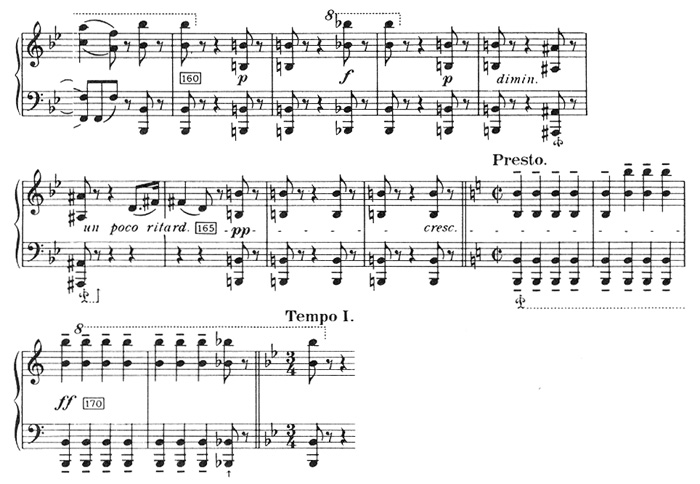
Example 14 shows the Neapolitan functioning as a secondary dominant of V (!) in conjunction with a chain of suspensions in the upper register.
Ex. 14. Beethoven, Sonata in B-flat Major, Opus 106, third movement (Adagio sostenuto), measures 21-28.
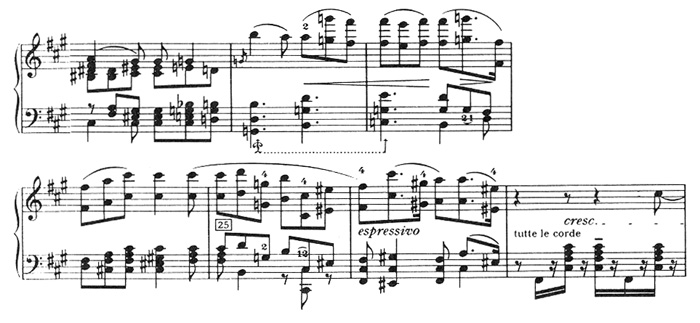
Following this wild excursion in measures 22-24, Beethoven conforms to tradition in measures 25-26. And here we see the two faces of the ancient Janus in the brief time-span of five bars.
A history of music theory that traces harmonic details in an evolutionary sense has yet to be published. A historical approach of this kind would necessarily focus upon important innovative composers. It would show in some detail the harmonic language the composers inherited and then set about showing how they manipulated details to serve their own needs and inspirations. This presentation focusing upon Beethoven's imaginative uses of the Neapolitan region is an effort in this direction.
Excerpts from the Associated Board edition of the Beethoven Pianoforte Sonatas, edited by Craxton and Tovey, used by permission of the Associated Board of the Royal Schools of Music.
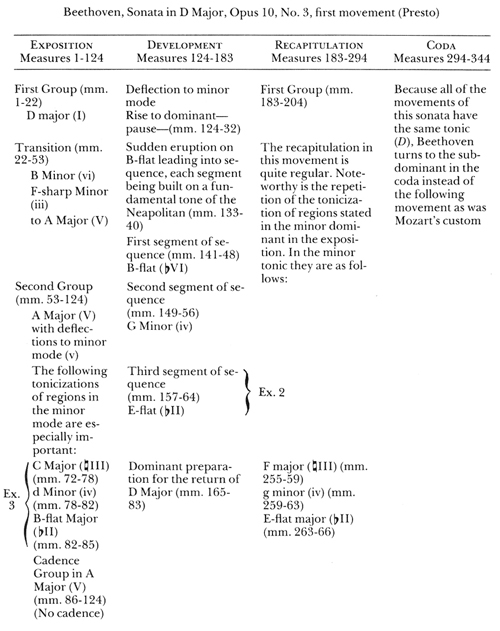
Beethoven, Sonata in C-sharp Minor, Opus 27, No. 2, third movement (Presto agitato)
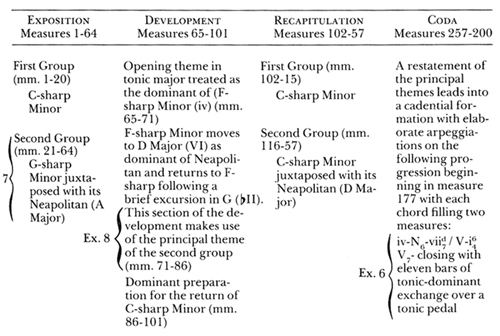
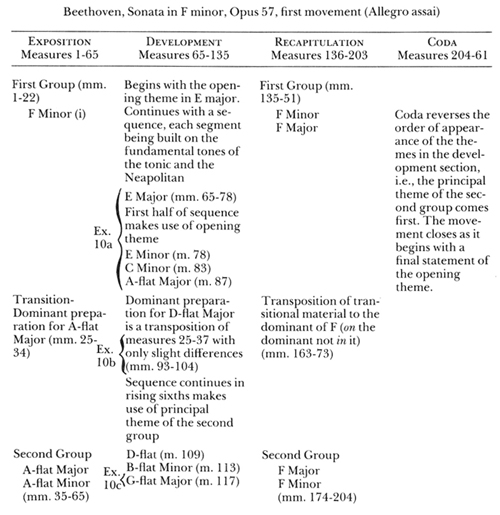
1Franz Liszt, Letters, col. and ed. by La Mara (Maria Lipsius), trans. by Constance Bach (New York: Haskell House Publishers, Ltd., 1968), Vol. II, pp. 369, 492.
2Donald F. Tovey, "Tonality in Schubert," in The Main Stream of Music and Other Essays (New York: World Publishing Company, 1959), pp.147-48.
3The Musical Experience (Princeton, New Jersey: Princeton University Press, 1950), pp. 44-45.
4Thematic Patterns in Sonatas of Beethoven (New York: The Macmillan Company, 1967), pp. 77-78.


